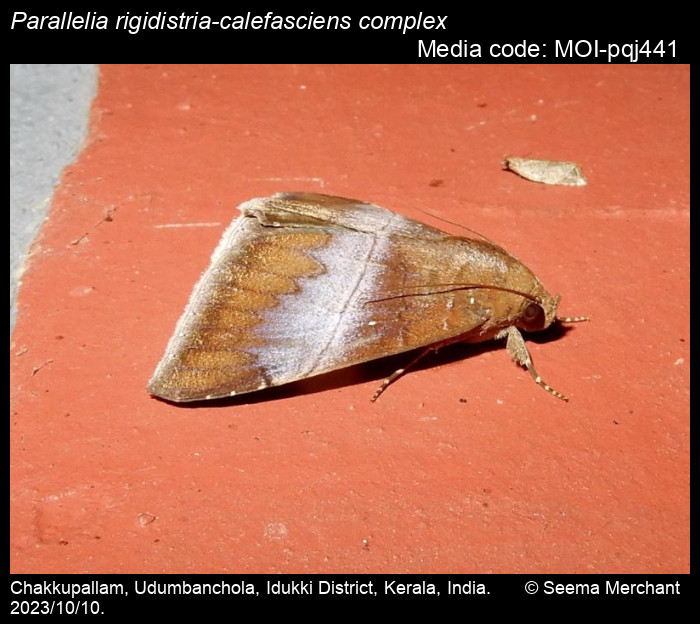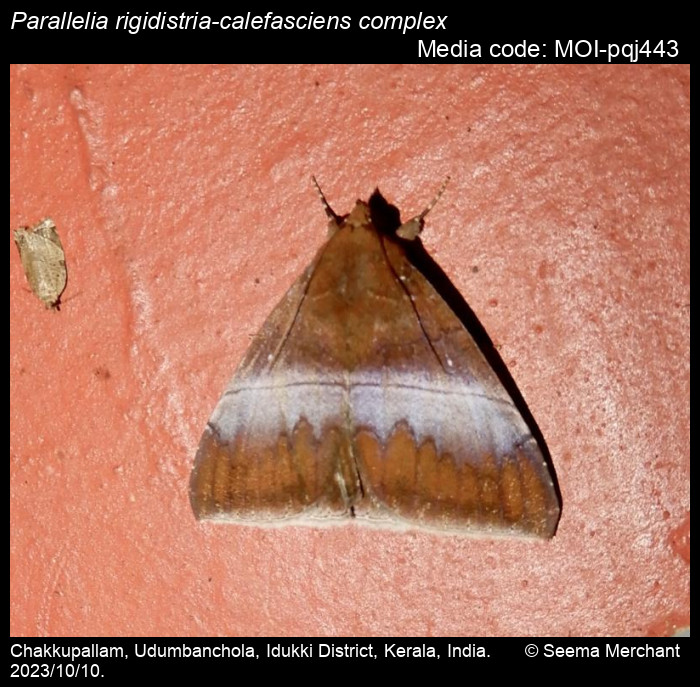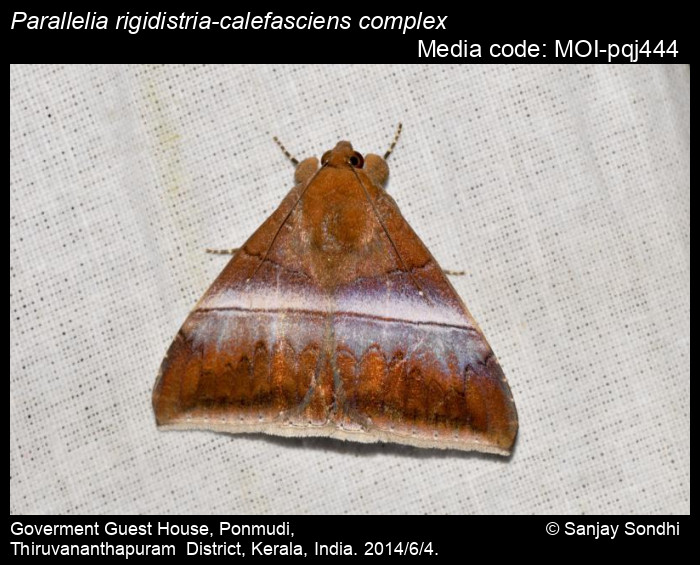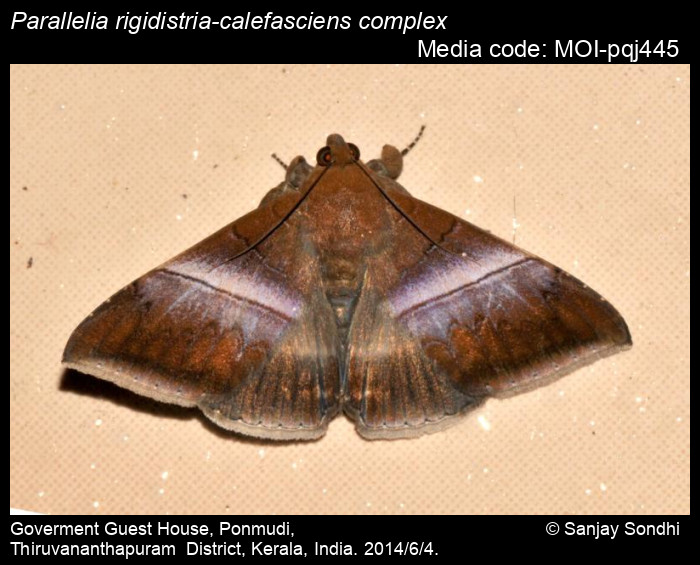
Photo Gallery and Species Biology
Compiled by Jonathan Dsilva.
Noting the sequence of descriptions -
1852 - rigidistria, Guenee, described from a female specimen from Central India. mentions the FW medial line "bordered internally by melted white-lilac" (translated)
1858 - calefasciens, Walker described from specimens from Sylhet(?) & Ceylon, mentions the FW medial line "broadly bordered by whitish lilac on the inner side"
1884, Lep. of Ceylon, Moore Vol 3 - calefasciens, describes the medial line as - "straight inwardly-oblique line, which has a broadly diffused purplish-lilacine white inner border in the male, and is broadly bordered on both sides with lilacine-white in the female" . The plate 168/3 is supposedly of a male. but this has lilacine white diffusion on both sides of the medial line. Probably, he has got the descriptions reversed.
1894, MOI, Hampson Vol 3, combines calefasciens under rigidistria, mentions "medial whitish band with a dark line on its outer edge", i.e. as above. TL includes Sylhet & Ceylon
1989, Holloway, MOB, calefaciens , in comparison to Buzara mentions the medial line "usually has a paler zone grading away basad rather than one distad". Also "There is also a diagnostic but small pale dot in the cell basal to the straight line.". In the taxonomic note, Holloway refers to "rigidistria complex" mentioned in Holloway, J.D. and Miller, S.E., 2003. The image shown is of a female, but without much lilac-white medial diffusion. He also mentions - "This dissection has also indicated that rigidistria Guenée is restricted to the Indian Peninsula and Sri Lanka". "The concept of calefaciens presented here is that of the Doubleday (?Silhet) syntype, a male (slide 18381); the Sri Lankan syntype has not been located.". The TL mentioned here does not include S. India or Sri Lanka
2013, MOT, Vol3 pt2, Kononenko & Pinratana, has both calefasciens & rigidistria, & the TL for both includes India, Bangladesh & Sri Lanka. The image of rigidistria has pale diffusion on both sides of FW medial line, while calefasciens does not.
Inaturalist - rigidistria, has images with diffusion, from S.India as well as NE India. calefasciens has images without diffusion from S.India & NE India. also has a few images with diffusion from S. India.
In conclusion - if Moore is correct, then the presence of diffusion on one or both sides may be used to distinguish male from female
If Holloway is right, then all images from S.India (including peninsular India) should be rigidistria, while those from NE India, should be calefasciens. But then the presence or absence of diffusion would not be a diagnostic feature.
If the separation based on medial diffusion is correct, then both species ranges overlap.
There is no mention in any of the above references to distinguish the two species by the medial line diffusion or from HW patterns. Need to check if there are any such references.
| State | Jan | Feb | Mar | Apr | May | Jun | Jul | Aug | Sep | Oct | Nov | Dec | No date |
|---|---|---|---|---|---|---|---|---|---|---|---|---|---|
| Andaman and Nicobar Islands | |||||||||||||
| Andhra Pradesh | |||||||||||||
| Arunachal Pradesh | |||||||||||||
| Assam | |||||||||||||
| Bihar | |||||||||||||
| Chandigarh | |||||||||||||
| Chhattisgarh | |||||||||||||
| Dadra & Nagar Haveli | |||||||||||||
| Daman & Diu | |||||||||||||
| Delhi | |||||||||||||
| Goa | |||||||||||||
| Gujarat | |||||||||||||
| Haryana | |||||||||||||
| Himachal Pradesh | |||||||||||||
| Jammu and Kashmir UT | |||||||||||||
| Jharkhand | |||||||||||||
| Karnataka | |||||||||||||
| Kerala | 1 | 1 | |||||||||||
| Ladakh UT | |||||||||||||
| Lakshadweep | |||||||||||||
| Madhya Pradesh | |||||||||||||
| Maharashtra | |||||||||||||
| Manipur | |||||||||||||
| Meghalaya | |||||||||||||
| Mizoram | |||||||||||||
| Nagaland | |||||||||||||
| Odisha | |||||||||||||
| Paschimbanga | |||||||||||||
| Pondicherry | |||||||||||||
| Punjab | |||||||||||||
| Rajasthan | |||||||||||||
| Sikkim | |||||||||||||
| Tamil Nadu | |||||||||||||
| Tripura | |||||||||||||
| Uttar Pradesh | |||||||||||||
| Uttarakhand | |||||||||||||
| West Bengal | |||||||||||||
| Total | 1 | 1 |
- Ophiusa rigidistria Guenée, 1852 in Boisduval & Guenée, Histoire Naturelle des Insectes. Species général des Lépidoptéres 7: 240 (Ophiusa) (holotype: female, Central India, NHM (BMNH), London).
- Ophiusa rigidistria; Hampson, G. F. 1894. The Fauna of British India including Ceylon and Burma. Moths, Vol. 2. Taylor & Francis, London. Arctiidae, Agrostidae, Noctuidae 609 p - 325 figs.Pg. 496, # 2488.
- Parallelia rigidistria; Holloway, J.D. and Miller, S.E., 2003. The composition, generic placement and host-plant relationships of the joviana-group in the Parallelia generic complex (Lepidoptera: Noctuidae, Catocalinae). Invertebrate Systematics, 17(1), pp.111-128.
- Parallelia rigidistria; Kononenko, V. S. & A. Pinratana. 2013. Moths of Thailand, Volume 3: Noctuoidea Part 2: Addendum to Vol. 3, Part 1, Families Erebidae, Nolidae, Euteliidae, Noctuidae and Checklist. Brothers of St. Gabriel in Thailand, Bangkok. 625 pp. + 55 pls. Pl. 15/13.
- Sivasankaran, K. and Ignacimuthu, S., 2014. A report of Erebidae (Lepidoptera: noctuoidea) from the Tamil Nadu part of the Western Ghats, India. Journal of the Bombay Natural History Society, 111(3), pp.193-209.
- Sondhi, S., Y. Sondhi, T. Karmakar & K. Kunte. 2021. Moth diversity (Lepidoptera) of Shendurney and Ponmudi in Agastyamalai Biosphere Reserve, Kerala, India: an update. Tropical Lepidoptera Research 31(3): 166-178. Pg. 170, Pl. 2/23.
- Dysgonia rigidistria; Sondhi, S. 2024. Moths of India - A Field Guide. Published by Titli Trust. xii+280 pp. Pl. 83/75.
Note: A detailed review of the Parallelia rigidistria and Parallelia calefasciens reveal that this is species complex that needs review and revision. The whitish diffused band is not a reliable feature for identification. See notes in Identification section.
Page citation
Anonymous 2025. Parallelia rigidistria-calefasciens complex (Guenée, 1852) – . In Sondhi, S., Y. Sondhi, R.P. Singh, P. Roy and K. Kunte (Chief Editors). Butterflies of India, v. 3.9. Published by the Indian Foundation for Butterflies. URL: https://mothsofindia.org/parallelia-rigidistria-calefasciens-complex, accessed 2025/04/23.









